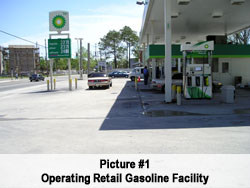Problem
The site is located at 1922 Kings Road in Jacksonville Florida (Picture 1). The site is bordered by residential properties to the west, south and southeast, and with small retail businesses to the north, northeast and east. The property is currently used as a retail vehicle fueling station and convenience store with four 8,000-gallon underground storage tanks (USTs): three USTs store and dispense various grades of unleaded gasoline and the fourth stores and dispenses kerosene. All four operating tanks were installed in November of 1984.
Petroleum contamination was noted during the 1984 tank removal activities and, in 1987, the FDEP was notified of petroleum contamination at the site through an Early Detection Incentive (EDI) Notification Application. Leaded gasoline, unleaded gasoline, and kerosene tank overfilling was listed as the probable cause of contamination. In July of 1987, the site was determined eligible for state funded cleanup assistance through the EDI program. Initial assessment activities were conducted in 1993 and 1999. Additional assessment conducted by TERRA-COM in 2000, 2001, and 2002 identified soil and groundwater contamination throughout the site across both the eastern and western dispenser islands. The owner did not have plans to upgrade the UST system or the dispensing infrastructure. Therefore source removal was not an option for this site. The problem, therefore, was to develop a remedial strategy that was effective, but yet did not interfere with the ongoing business or infrastructure of the site.
Solution
TERRA-COM conducted a vacuum extraction and air sparging pilot test in October 2002. The results of this pilot test were moderately successful and TERRA-COM prepared a Remedial Action Plan (RAP) using this data in December 2002. However, FDEP did not approve this RAP due to the implementation of the Remedial Action Initiative (RAI) in June 2003.
FDEP required a second pilot test to insure the RAP would meet the requirements of the RAI. This test was performed in January 2004 and confirmed the results of the first pilot test. TERRA-COM re-submitted a Remedial Action Plan Modification (RAPM) incorporating the results of both tests and changing the design of the VE wells, to a horizontal construction. This would allow for a greater vacuum and greater air flow given the relatively shallow water table at the FCE #1037 site (3 to 5 feet below land surface).
TERRA-COM installed the specified system in June 2005 (Picture 2, Picture 3, Picture 4, Picture 5, & Picture 6). The installation was performed incrementally in order to minimize the impact to the ongoing business. At no time was the business shut down due to construction efforts. The system was started in July 2005. The remedial system compound was located at the rear of the property behind a wood fence where it is virtually out of site (Picture 7 & Picture 8).
Operation of the system has been ongoing for 12 months and groundwater analytical results indicate that groundwater concentrations are below both Natural Attenuation Default Concentrations and Groundwater Cleanup Target Levels. The system will likely be turned off for one to two quarters in order to verify that the groundwater at the site has indeed been cleaned up. If the groundwater concentrations remain below GCTLs, the site will have cleaned up in less than half the anticipated time with minimal impact to the store. Upon issuance of a Site Rehabilitation and Completion Order, TERRA-COM will remove the existing system and restore the site to its original condition.


